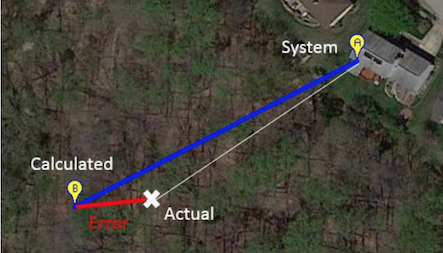Home
A comprehensive resource for safe and responsible laser use
US: Student develops experimental laser location detection device
The system is intended for use in cockpits, and is self-contained — it does not need to interface with any aircraft instruments. For location, altitude and orientation data, it has a GPS and a 3-axis magnetic compass.
A laser is detected by a camera sensor, currently with 1024 x 1024 pixel resolution. The camera detects the bright “bloom” from a direct or near-direct laser illumination (left image, below). To distinguish laser light from a bright non-laser light such as the sun, it looks at surrounding pixels to see whether they saturate the green channel of the sensor. (The system currently looks only for green laser beams since those represent over 90% of FAA-reported laser incidents. But future versions could look for other color laser beams as well.)

As the laser aims away from the camera, the bright center of the laser is still visible (right image, above). The system then looks at the center of the bright area to find the pixel location. Knowing the camera’s orientation, location and altitude, a Raspberry Pi computer running a Python program written by Hough calculates the approximate location. This is automatically sent via text message to pre-programmed recipients which could include law enforcement.
In ground testing on a slope, at a relatively short distance, the error was 15 meters. As the photo diagram shows, the system was successful in determining an approximate distance and location.

Hough notes that the system is a low-cost proof-of-concept. Suggested improvements include “more precise location sensors [that] would improve target location accuracy. Tapping into the high quality compass and GPS sensors on a commercial aircraft, for example, would drastically improve the ability of the system.” He also stated that smartphones include all the equipment needed: camera, compass, GPS, processor and display. So it should be possible to make a smartphone application to accomplish the same task.
From “Detection and Location System for Laser Interference with Aircraft”, December 2016. Thanks to Nate Hough for bringing this to our attention and allowing us to host the PDF. Note: A similar system, which does not calculate the laser source location, is the Laser Event Recorder.
US: New Virginia law makes it a misdemeanor to knowingly aim at an aircraft
The bill amends the Commonwealth’s Acts of Assembly Chapter 5.1-22, covering interference with aircraft to also prohibit “projecting a point of light from a laser, laser gun sight, or any other device that simulates a laser at an aircraft…” The only exception is for persons authorized by the Federal Aviation Administration or by U.S. armed forces. Violation is a Class 1 misdemeanor, punishable by up to 12 months in jail and/or a fine of up to $2,500.
From the Virginia Legislative Information System and FairfaxTimes.com.
US: Va. Beach wants state of Va. to ban aiming lasers at airplanes
The City Council is considering a local law to make malicious shining of lasers a Class 1 misdemeanor (up to a year in jail and a $2500 fine). According to PilotOnline.com, in 1998 Virginia Beach “was one of the first in the nation to make it a crime to shine lasers at police officers or into people’s eyes.”
The city is also planing an educational campaign to inform people about the law and laser dangers.
Commenter “Lost_Sailor” said there already is a Virginia state code, 5.1-22, “Interference with operation of aircraft,” to address the problem. He linked to a 2002 Virginia Court of Appeals case upholding the conviction of a man for using a “million candlelight spotlight” to illuminate a police helicopter. The man unsuccessfully argued that he had no intent to interfere with the helicopter; he wanted to view its registration number for a noise complaint. The man also unsuccessfully argued that his spotlight did not interfere with the operation of the aircraft.
From PilotOnline.com. The comment by Lost_Sailor was submitted on Thursday, 10/06/2011 at 6:40 pm.